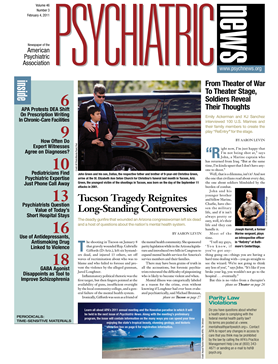A large percentage of suicide attempts—60 percent—can be attributed to just four mental disorders—major depressive disorder, borderline personality disorder, nicotine dependence, and posttraumatic stress disorder (PTSD).
This finding, from two Canadian researchers, was reported in the December 2010 American Journal of Public Health.
The researchers were James Bolton, M.D., an assistant professor of psychiatry and psychology at the University of Manitoba, and Jennifer Robinson, M.A., a doctoral student in clinical psychology at the same university.
Bolton and Robinson arrived at this conclusion by applying a statistical tool called the population-attributable fraction (PAF) to data from the National Epidemiologic Survey on Alcohol and Related Conditions (NESARC), wave two. The PAF is based on the assumption that the examined risk factor is causally related to the outcome. The NESARC, wave two, consisted of a comprehensive assessment of lifetime Axis I and Axis II mental disorders in a representative sample of the United States population—some 35,000 Americans—during 2004 and 2005.
Twenty-seven percent of the suicide attempts could be attributed to major depressive disorder, Bolton and Robinson found. This high percentage did not surprise them since mood disorders had already been strongly linked to suicide attempts. Eighteen percent of the suicide attempts could be attributed to borderline personality disorder. This finding was also expected since this disorder had also already been strongly linked to suicide attempts.
However, that 6 percent of the attempts could be attributed to PTSD did surprise them. “Anxiety disorders are now more recognized as risk factors for suicidal behavior than they used to be, but our findings, together with other recent publications, suggest that PTSD may be the most important among all the anxiety disorders in this regard,” Bolton told Psychiatric News.
But the finding that really intrigued them concerned nicotine dependence.
They found that 8 percent of the suicide attempts could be linked to it. “Smoking has received very little attention in the literature of suicide-attempt risk factors,” they noted, “and, to our knowledge, smoking has never been examined by using PAFs. . . . The nicotine dependence PAF of 8.4 percent has considerable public health implications. . . . Our results suggest that in the absence of nicotine dependence among the population, 1 million fewer Americans would attempt suicide.”
Yet if nicotine dependence can truly provoke suicide attempts, how might it do so? “It is possible that nicotine has a prosuicidal effect on the brain,” said Bolton. “There is evidence showing that nicotine reduces serotonin levels in the brain, and the latter is associated with suicidal behavior. Also, suicide has been linked with greater amounts of cigarettes smoked, indicating a possible dose effect. Alternatively, there may be a shared common factor among smokers, such as impulsivity, that predisposes to suicidal behavior,” he noted.
The study also found that some disorders that one might expect to extensively contribute to suicide attempts did not do so. For example, only 5 percent of suicide attempts could be attributed to bipolar I and bipolar II disorder.
The results “should help clinicians refine their risk assessment for suicidal behavior in patients,” Bolton said. “By examining the PAF, we have clarified four specific disorders that independently account for a large percentage of suicide attempts and therefore should be assessed when determining the risk for suicidal behavior in patients. The findings for nicotine dependence also emphasize the need for psychiatrists and other clinicians to promote smoking cessation in their patients. Smoking has already been associated with numerous negative health outcomes, and suicidal behavior is now an additional reason for concern with smoking.”
“Overall, the study is strong and provides good and new evidence,” Paula Clayton, M.D., medical director of the American Foundation for Suicide Prevention in New York City, told Psychiatric News. However, it does contain some weaknesses, she pointed out. For example, “Both the mental disorders being studied and the suicide attempts recorded are ‘life time’ (ever in your lifetime) diagnoses or events, so it is unclear if one can be related to the other. As the authors state, the suicide attempt may have come before the mental disorder, or the mental disorder could be in remission—like college alcohol abuse—before the suicide attempt occurred.” Also, “Suicide attempts are not a strong risk factor for eventual suicide. In fact, the majority of people who make suicide attempts do not go on to kill themselves.”
“The study is interesting from a population perspective,” Joel Yager, M.D., a professor of psychiatry at the University of Colorado, commented. “But when you are an individual psychiatrist seeing patients one on one,” it is best to consider a number of factors regarding suicide risk, not just that a large percentage of suicide attempts can be attributed to only four mental disorders. These factors, he noted, include the person's age, gender, ethnicity, possession of firearms, alcohol and substance use, impulsivity, anger, history of self-harm, violence towards others, and family and social support.
The study was funded by the Manitoba Health Research Council and the Canadian Institutes for Health Research.
